In order to arrange ceilings in accordance with the design of the room, it is often necessary to change their design, carefully select materials for finishing, which in general is not an easy, but quite solvable matter. In private houses, beams for ceiling ceilings, as a rule, are made from a bar with a section of 150x150 or 150x200 mm. This provides a sufficient level of strength to withstand any ceiling liner.
Sheathing of ceiling slabs
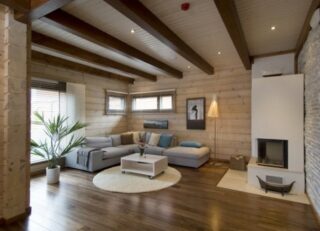
Attic floors must be insulated, for which they use thermal insulation materials, which must be protected from exposure to vapors and humid air. Provide such protection using special vapor and waterproof membranes.
Interfloor floors do not need to be specially insulated - it is enough to lay a layer of sound-insulating material on them, which at the same time will provide the necessary level of thermal insulation.
The choice of the technology for laying soundproof and insulating materials on ceiling slabs depends on the method of filing the finish:
- the use of floor beams as decorative elements;
- complete concealment of the ceiling with decorative material.
If the ceiling is supposed to be completely hidden, the sound insulator and insulation are placed between the beams. Further, from the side of the room, the vapor barrier and the finishing of the ceiling are hemmed. The waterproofing and floor covering of the upper floor / attic is laid on top of the joists.
If a decision is made to use floor beams as decorative elements, the final finishing of the ceiling in a private house is hemmed from the inside to special wooden elements fixed to the side surfaces of the ceiling.
Ceiling finishes
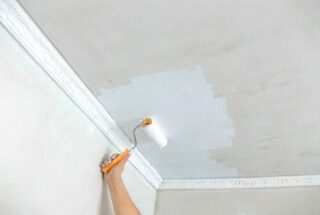
All options for finishing ceilings can be roughly divided into budget, practical and durable and elite.
Whitewashing and painting
The most common types of ceiling finishes are painting and whitewashing. Both options are great for low-rise spaces. Light shades of ceilings allow you to visually increase the height of the rooms.
The main tools are a roller, brush or spray gun.
A whitewash mixture is prepared from chalk or lime. The material is mixed with water to the desired consistency. Any of the prepared compositions is applied in several layers, waiting for the previous layer to dry completely.
The paints used to paint ceilings differ in composition:
- water-based;
- acrylic;
- silicone, etc.
They are also subdivided into glossy, semi-glossy and matte, which allows you to achieve the desired decorative effect in any room interior. In some cases, homeowners can afford artistic ceiling painting.
Decorative plaster
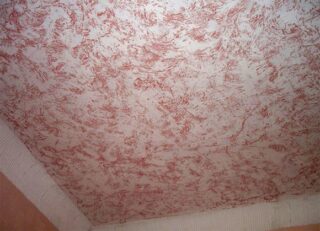
Quite often, when finishing the ceiling, decorative plaster is used, which allows you to apply a textured finish to the prepared surface.
There are two types of decorative plaster:
- Textured - a ready-to-use mixture, which includes granular decorative fillers (quartz, marble or granite chips), differing in the size of the granules.
- Structural - white plastic mass. To apply it and create a relief pattern, you will need a special tool.The plaster acquires the desired shade by adding a special tinting solution or by subsequent painting of the surface.
In addition to the beautiful and non-standard relief, decorative plaster allows you to mask minor defects on the ceiling. However, its application will most likely require the involvement of qualified specialists.
Wallpaper
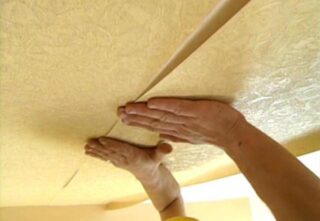
Another popular way to decorate the ceiling is to wallpaper them. Depending on the main components that provide the coating features, wallpapers are:
- paper;
- vinyl;
- non-woven, etc.
There are liquid wallpapers that differ from traditional ones in structure and method of application. They are a dry mixture of paper and decorative components, which must be mixed with water and applied to the ceiling. This work is done with a spatula and a trowel. The advantage of this coating is the ease of restoration of damaged areas - moisten the damaged fragment with water, remove and apply a new one.
Expanded polystyrene tiles
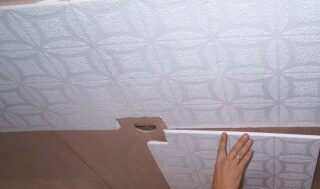
Another of the quick and relatively uncomplicated methods of finishing ceiling surfaces is pasting with expanded polystyrene tiles. They come in various sizes, colored or white, with or without embossed patterns. These tiles are easy to install and dismantle, they are resistant to moisture. Among the disadvantages:
- fire hazard;
- low level of strength.
The instability of expanded polystyrene tiles to sunlight is also considered a serious drawback.
Dropped ceilings
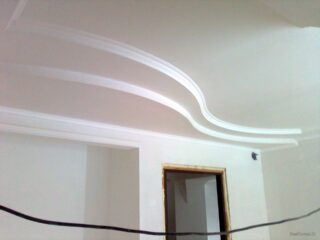
Materials are very popular, the installation methods of which do not require preliminary surface preparation. They are able to hide defects and laid communications.
False ceiling structures:
- from drywall;
- from laminate;
- from PVC film, etc.
Plasterboard is one of the most demanded materials that are widely used for finishing ceilings and walls. Suspended structures with its use are mounted on frames made of metal profiles or on a lathing made of wooden battens, which are attached to the ceiling. The decoration of the surfaces obtained in this case can be carried out in almost any way.
Disadvantages - significant weight of the structure and insufficient moisture resistance, which does not allow its use when decorating rooms with high humidity.
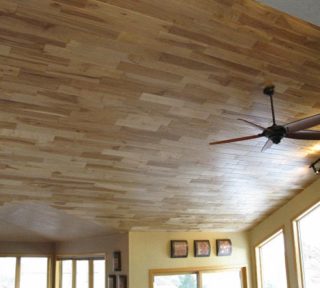
For finishing the ceilings, they began to use laminate, which had previously been used only for flooring. Imitating natural wood, it is able to give the room a cosiness, while performing the functions of sound and heat insulation. Suspended ceilings using laminate flooring are different:
- a wide variety of colors;
- high mechanical strength;
- environmental friendliness.
The disadvantage of laminate with all its advantages is its very low moisture resistance.
Arrangement of stretch ceilings made of PVC film makes it possible to equip a seamless coating that can transform a room beyond recognition. Possessing a number of advantages, among which not the last place is high moisture resistance, suspended ceilings made of PVC film are unstable to mechanical stress and are distinguished by high cost.
Materials selection rules
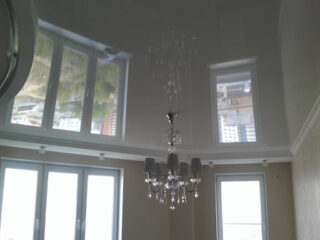
Ceiling decoration in a country house is considered one of the most laborious stages of work. When choosing a finishing material, you cannot rely only on your own preferences - you need to follow certain rules, the determining one of which is the purpose of the room. Having pasted wallpaper on the ceiling of the bathroom, after a very short time you will have to remove them and start all the finishing all over again, since the wallpaper will swell from excess moisture.
It is necessary to take into account the quality and visually imagine the effect created by the selected material.This will help you visually adjust the dimensions of the rooms. For example, a suspended ceiling with glued mirror tiles will reflect light, visually increasing the height of the room.
It is equally important to arrange the ceiling so that it does not draw too much attention to itself. It is important that the finish harmoniously complements the existing furnishings.
For finishing the ceiling, you can use any materials that meet the following characteristics:
- do not require special care;
- have a long service life;
- are simply mounted.
Finishing the ceiling in a country or residential building without fail requires compliance with safety measures in relation to the people in the room. If, for example, a suspended ceiling covers electrical wiring, use non-flammable and non-conductive materials.








